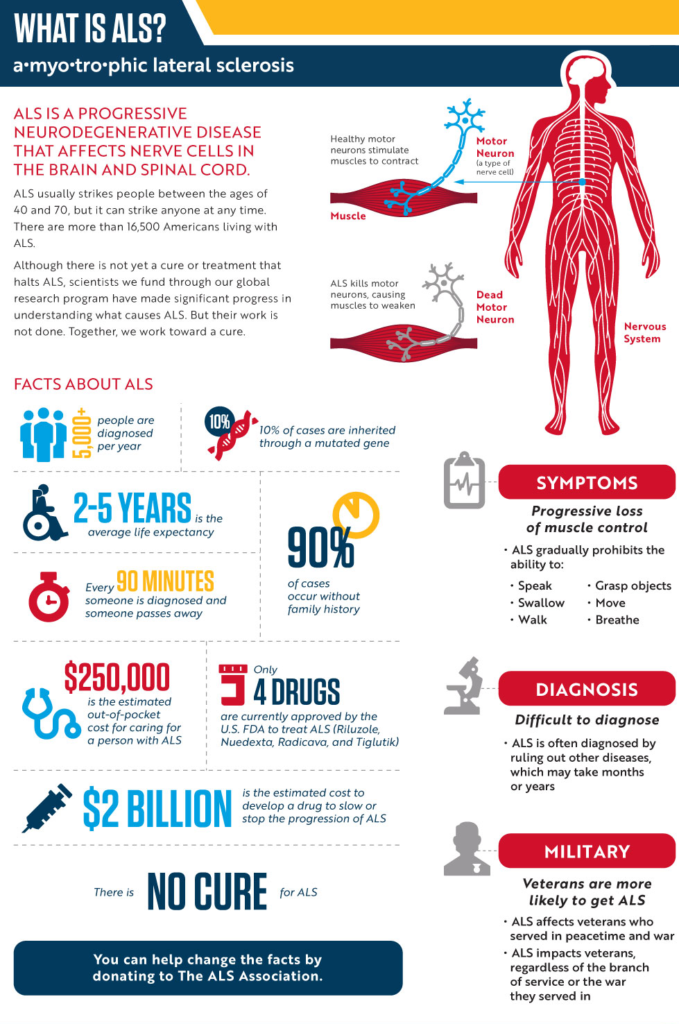Adapted from:
ALS Association Golden West Chapter
Health Communities
Mayo Clinic
Amyotrophic lateral sclerosis (ALS), also called Lou Gehrig’s disease, is a progressive neuromuscular disease that weakens and eventually destroys motor neurons— components of the nervous system that connect the brain with the skeletal muscles.
Upper motor neurons are located in the cerebral cortex of the brain and conduct impulses from the motor cortex to nerves in the brain or the spinal cord. Lower motor neurons are peripheral neurons that originate in the spinal cord and conduct impulses to the skeletal muscles. Skeletal muscles are involved with voluntary movements, such as walking and talking. The lower motor neurons transmit the command to move from the brain to the skeletal muscles, which respond by contracting.
A person with ALS usually presents with problems in dexterity or gait resulting from muscle weakness, or with difficulty speaking or swallowing. Sphincter control, sensory function, intellectual ability, and skin integrity are preserved. Patients become paralyzed and often require ventilation and surgery to provide a new opening in the stomach (gastrostomy). Loss of respiratory function is ultimately the cause of death for people who have ALS.
Incidence and Prevalence of ALS
Approximately 30,000 patients in the United States currently have ALS. The disease has no racial, socioeconomic, or ethnic boundaries. The life expectancy of ALS patients usually ranges from about 3 to 5 years after diagnosis.
ALS is 20 percent more common in men than in women. However, with increasing age, the incidence of ALS is more equal between men and women.
About 90 percent of ALS cases occur without family history. The remaining 10 percent of ALS cases are inherited through a mutated gene. On average, it takes about one year before a final ALS diagnosis is made.

ALS signs and symptoms
Once a motor neuron degenerates completely, the muscle that it controls no longer receives impulses from the brain. Approximately 60 percent of ALS patients experience muscle weakness and stiffness as the initial symptom.
Usually the first muscles affected are those in the arms and legs. Walking or climbing stairs may become difficult. The patient may drop things, fall, experience muscle cramps, and laugh or cry uncontrollably. The arms and legs may feel especially tired. If the hands are affected, the patient may have difficulty picking up small objects or turning keys. Speech problems, such as slurring, hoarseness, or decreased volume may also occur.
- Loss of muscle tone (hypotonia)
- Absence of spinal reflexes (areflexia)
- Muscle twitching (fasciculations)
- Muscle wasting (atrophy)
Signs that upper motor neurons are affected include:
- Excessive salivation
- Extension of the big toe and abduction of the rest of the toes in response to lightly stroking the sole of the foot (Babinski’s sign)
- Frontotemporal dementia (FTD)
- Hyperactive tendon reflexes
- Impaired speech (dysarthria)
- Impaired swallowing (dysphagia)
- Increased muscle tone and rigidity (spasticity)
- Rapidly alternating muscle contractions and relaxations (clonus)
As symptoms progressively worsen, the patient’s muscles atrophy causing spasticity, stiffness, abnormal movements, and alterations in gait and manual dexterity. Twitching may occur in the tongue and in affected limbs. The patient may experience muscle pain and muscle cramps.
Some patients experience more difficulty swallowing saliva and liquids than solid food. Excessive salivation and difficulty swallowing may cause drooling. When respiratory muscles weaken, the patient may require a ventilator.
ALS patients often experience fear, anxiety, and depression.
Complications
As the disease progresses, ALS causes complications, such as:
Breathing Problems
Over time, ALS paralyzes the muscles you use to breathe. You might need a device to help you breathe at night, similar to what someone with sleep apnea might wear. For example, you may be given continuous positive airway pressure (CPAP) or bilevel positive airway pressure (BiPAP) to assist with your breathing at night.
Some people with advanced ALS choose to have a tracheostomy–a surgically created hole at the front of the neck leading to the windpipe (trachea)—for full-time use of a respirator that inflates and deflates their lungs.
The most common cause of death for people with ALS is respiratory failure. On average, death occurs within three to five years after symptoms begin. However, some people with ALS live 10 or more years.
Speaking Problems
Most people with ALS develop trouble speaking. This usually starts as occasional, mild slurring of words, but becomes more severe. Speech eventually becomes difficult for others to understand, and people with ALS often rely on other communication technologies to communicate.
Eating Problems
People with ALS can develop malnutrition and dehydration from damage to the muscles that control swallowing. They are also at higher risk of getting food, liquids or saliva into the lungs, which can cause pneumonia. A feeding tube can reduce these risks and ensure proper hydration and nutrition.
Dementia
Some people with ALS have problems with memory and decision-making, and some are eventually diagnosed with a form of dementia called frontotemporal dementia.
ALS Prognosis
Amyotrophic lateral sclerosis is a terminal illness. Fifty percent of patients die within 3 years of diagnosis; 20 percent live 5 years; and 10 percent live 10 years. Hospice care can provide comfort and dignity to patients and their loved ones.


Oh dear ones, you both have been and will continue to be in our prayers for the Lord to meet each one of your needs in His time. We will welcome being more informed as to changes, etc., so we can pray more intelligently for you, Leslie, and Jon. We’re well aware when your loved one is affected, it’s NOT a lonely, for you hurt & ache along with them, oftentimes in frustration as to the best way to help them & assure them they are loved, unconditionally!! We may not be physically able able to kneel to pray to the Great Physician, but our hearts are kneeling as we pray for you.
I wanted to tell you again how much I have been blessed by your musical talent as you’ve shared it with Baywood, always playing with your heart as well as your hands – each time He was glorified as you played. Thank you!! ❤️❤️
Thank you, Gary and Freddie. We know you’re well acquainted with illness. Your prayers and love are wonderful and an encouragement.
A poignant reminder to be thankful. So thankful Jon is there to encourage you to keep your focus on what you have (not what you don’t have). You are so blessed with the gift of each other. We are ALL blessed to have you both! <3
Thank you, Wendy❣️ So appreciate your words of reassurance. Means more than words can adequately express.